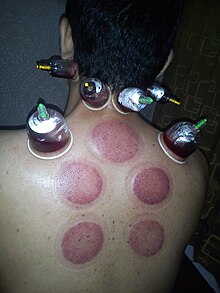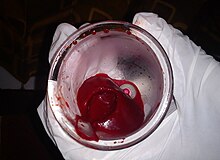| Revision as of 08:18, 12 June 2012 editBobrayner (talk | contribs)Autopatrolled, Extended confirmed users, Pending changes reviewers, Rollbackers53,710 edits punctuation fix← Previous edit | Revision as of 19:50, 16 June 2012 edit undoHacksBack (talk | contribs)60 edits Undid revision 496989013 by Bobrayner (talk) STOP VANDALISMNext edit → | ||
| Line 1: | Line 1: | ||
| ] | ] | ||
| '''Hijama''' ({{lang-ar|حجامة}} lit. "sucking") is the name in ] ] for ], where blood is drawn by vacuum from a small skin incision for ] purposes.<ref>, Albinali, H. A. Hâyar, ''Heart Views'', Volume 5, No.2, June–August 2004</ref> Hijama is generally performed by ]s as it is a form of medicine specifically mentioned and encouraged by |
'''Hijama''' ({{lang-ar|حجامة}} lit. "sucking") is the name in ] ] for ], where blood is drawn by vacuum from a small skin incision for ] purposes.<ref>, Albinali, H. A. Hâyar, ''Heart Views'', Volume 5, No.2, June–August 2004</ref> Hijama is generally performed by ]s as it is a form of medicine specifically mentioned and encouraged by ] ] (saw). Among other ], it is mentioned in that recorded by ] (5263) and ] (2952), saying "The Hijama is the best of your remedies" (خير ما تداويتم به الحجامة). | ||
| ==Ijaza== | |||
| It is an Islamic requirement to obtain an ] for hijama. <ref>, James McConnell, ''Hijama 101 Course' June 2012</ref> It is what differentiates hijama from standard cupping practices. Cupping has been practiced for thousands of years. Prophet Muhammad (saw) sanctioned the existing practice. The superior ijaaza system focuses predominately on vetting practitioners, making certain they are people of high moral character and honor. The technical aspects of hijama are quite easy to learn, but the standard of morality is extremely high and can only be licensed by someone of equal or higher moral character. Understandably, "Muslim" practitioners who do not meet this high moral standard are fighting the ijaaza requirement for practicing hijama. | |||
| In a paper titled Traditionalism in Islam: An Essay in Interpretation, Harvard professor William A. Graham explains the ijazah system as follows: | |||
| The basic system of "the journey in search of knowledge" that developed early in Hadith scholarship, involved travelling to specific authorities (shaykhs), especially the oldest and most renowned of the day, to hear from their own mouths their hadiths and to obtain their authorization or "permission" (ijazah) to transmit those in their names. This ] system of personal rather than institutional certification has served not only for Hadith, but also for transmission of texts of any kind, from history, law, or philology to literature, mysticism, or theology. The isnad of a long manuscript as well as that of a short hadith ideally should reflect the oral, face-to-face, teacher-to-student transmission of the text by the teacher's ijazah, which validates the written text. In a formal, written ijazah, the teacher granting the certificate typically includes an isnad containing his or her scholarly lineage of teachers back to the Prophet through Companions, a later venerable shaykh, or the author of a specific book. | |||
| ==Procedure== | ==Procedure== | ||
Revision as of 19:50, 16 June 2012

Hijama (Template:Lang-ar lit. "sucking") is the name in Arab traditional medicine for wet cupping, where blood is drawn by vacuum from a small skin incision for therapeutic purposes. Hijama is generally performed by Muslims as it is a form of medicine specifically mentioned and encouraged by Prophet Muhammad (saw). Among other hadith, it is mentioned in that recorded by Muhammad al-Bukhari (5263) and Muslim ibn al-Hajjaj (2952), saying "The Hijama is the best of your remedies" (خير ما تداويتم به الحجامة).
Ijaza
It is an Islamic requirement to obtain an ijaza for hijama. It is what differentiates hijama from standard cupping practices. Cupping has been practiced for thousands of years. Prophet Muhammad (saw) sanctioned the existing practice. The superior ijaaza system focuses predominately on vetting practitioners, making certain they are people of high moral character and honor. The technical aspects of hijama are quite easy to learn, but the standard of morality is extremely high and can only be licensed by someone of equal or higher moral character. Understandably, "Muslim" practitioners who do not meet this high moral standard are fighting the ijaaza requirement for practicing hijama.
In a paper titled Traditionalism in Islam: An Essay in Interpretation, Harvard professor William A. Graham explains the ijazah system as follows:
The basic system of "the journey in search of knowledge" that developed early in Hadith scholarship, involved travelling to specific authorities (shaykhs), especially the oldest and most renowned of the day, to hear from their own mouths their hadiths and to obtain their authorization or "permission" (ijazah) to transmit those in their names. This ijaza system of personal rather than institutional certification has served not only for Hadith, but also for transmission of texts of any kind, from history, law, or philology to literature, mysticism, or theology. The isnad of a long manuscript as well as that of a short hadith ideally should reflect the oral, face-to-face, teacher-to-student transmission of the text by the teacher's ijazah, which validates the written text. In a formal, written ijazah, the teacher granting the certificate typically includes an isnad containing his or her scholarly lineage of teachers back to the Prophet through Companions, a later venerable shaykh, or the author of a specific book.
Procedure

Hijama can be performed anywhere on the body, often at the site of an ache or pain in order to ease or alleviate it. A more conservative approach warns against over use of cupping and suggests only that six optimal points on the body are all that is required to "clean" the entire cardiovascular system: The back of the head, two shoulders corresponding to the acupuncture heart position, the tail or small of the back, and the two inner ankles.
The location is first shaved, if necessary, to ensure a tight seal with the cup. The mouth of a cup (metal, glass and plastic cups are generally used, although traditionally horns were used) is placed on the skin at the site chosen for cupping. Then a tight seal is created. The traditional method was to burn a small piece of paper or cotton inside the vessel, so that the mouth of the cup clings to the skin. Some practitioners now use a machine instead, although others strictly adhere to the Prophetic method with the use of fire, both for sterility and the benefits or properties from the element of fire itself. The cup is left to cling to the skin for a few minutes, then it is lifted off and a couple of very small incisions are made in the skin. The cup is then put back as it was before until the flow of blood subsides.
Hijama is considered a form of energy medicine because it has been claimed to unclog the meridians in the body, and is viewed by some practitioners as a cure that can alleviate black magic and possession.
See also
- Bloodletting
- Ijaza
- Fire cupping
- Medicine in medieval Islam
- Blood donation
- Hematology
- History of medicine
References
- Traditional Medicine Among Gulf Arabs Part II - Blood Letting, Albinali, H. A. Hâyar, Heart Views, Volume 5, No.2, June–August 2004
- Hijama 101 Course, James McConnell, Hijama 101 Course' June 2012
- Cupping, Hijama, Buhwang . . .
- Traditional Cupping Hijama Educational Course
- Observations of the popularity and religious significance of blood-cupping (al-ḥijāma) as an Islamic medicine, Ahmed El-Wakil, Contemporary Islamic Studies, Vol. 2011, 2